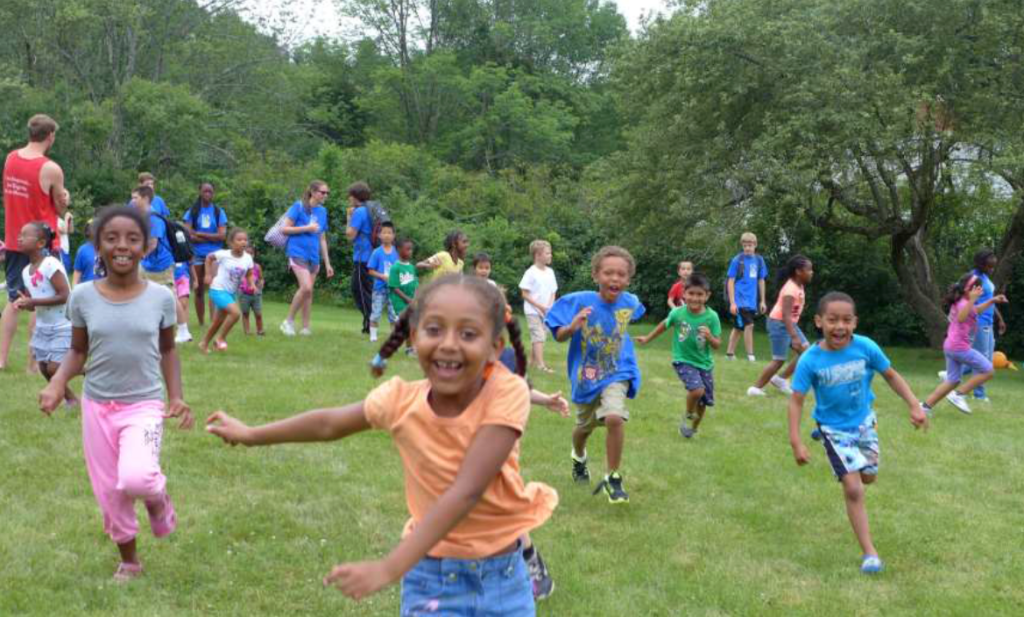
Children enjoy the green open space at Farrington Nature Linc.
By Alice C. Waugh
A century-old Lincoln facility originally built to offer rural respite to undernourished city girls has reinvented itself and hopes to expand its programs that connect low-income urban children to the natural world.
Lincoln is known for its farms and conservation land, but Farrington Nature Linc is a bit of a hidden gem with its own particular niche, said executive director Wendy Matusovich. “There are many nature programs in Lincoln, but none of them have exactly the same lens as we do, which is to focus exclusively on kids from urban communities who don’t otherwise have access to nature. So few people in the Lincoln area know what we really do or what we are,” she said.
“Now and then we’ll get a child who’s afraid to sit down or run barefoot on the grass because they don’t know what’s there,” Matusovich added. “They don’t know what it’s like to be quiet in nature.”
At the rear of Farrington’s 75-acre property just north of Route 2 sits a 1912 brick dormitory. In his will, Charles Farrington, who died in 1907 and posthumously created Farrington Memorial in honor of his parents, asked his trustees to purchase a “healthy and beautiful locality to which children may be sent for a longer or shorter time to recuperate their health and draw new life, physical, mental and moral, to meet the responsibilities that may come to them.”
After World War II, the City Missionary Society hosted a variety of programs on the property, and from 1977 to 2004, Gould Farm ran a community residence for young adults with mental illness. However, after they left and another tenant for the dormitory couldn’t be found, Farrington lost the occupancy license for the building. It’s no longer in use and has fallen into disrepair, with floors strewn with chunks of fallen plaster and bits of parquet. To return it to its full overnight functionality, Farrington would have to rebuild it from the inside to bring it up to code, which would cost several million dollars, Matusovich said.

A boy makes friends with a calf at Farrington Nature Linc.
Since 2002, the property (now called Farrington Nature Linc) has been managed as a summer and after-school educational site hosting visits by Boston-area groups of children for single-day and multi-day nature experiences. Kids get the chance to hike through Farrington’s 75 acres of woodlands, fields and ponds; look for tadpoles and frogs in their pond and vernal pools; learn how plants grow in Farrington’s garden; and meet farm animals loaned to Farrington in the summer by Codman Farm.
Farrington Nature Linc is aiming to serve more kids and offer programs at during the school year as well as the summer. In 2014, it ran day programs during school vacations for the first time, with snowshoeing, sledding and hot chocolate in February and salamander searching, art projects and “frog chorus” in April. It also piloted a summer overnight camping experience with the help of a grant from the Clipper Ship Foundation. As a result, 121 children experienced night hikes, campfires and star gazing for the first time.
Also on the Farrington property, which was once a working farm, are the original 18th-century barn and farmhouse, which is now rented to tenants and also used for Farrington’s office. With proceeds from grants, donations and fundraising events—including a family spring hike on April 18 and the Fairy Festival on May 16—the board (which includes Lincoln residents Brooks Mostue, Susan Taylor, Sandra Bradlee and Jane Tierney) hopes to winterize the barn to allow indoor programs during the cold months and add staff time. Staff noticed during the first February program that while the kids had winter coat, many did not have snow pants or waterproof boots, so they also plan to build up an inventory of winter gear for their young visitors.
“The board is committed to helping Farrington grow into a year-round organization,” Matusovich said. To that end, it hopes to eventually rehabilitate the dormitory building and also boost its endowment, which currently supports only the summer programming. It also hosts birthday parties, family hikes and other activities that are open to all. The actual cost for a summer day visit to Farrington Nature Linc is about $6 per child, but Farrington has a sliding scale, so most groups only pay $1 per child and Farrington subsidizes the difference, Matusovich noted. Eighty percent of the children who visit qualify for the federally subsidized lunch program
Matusovich herself was further inspired after hearing Richard Louv speak at a conference last year. Louv is founder of the Children and Nature Network and author of Last Child in the Woods: Saving Our Children From Nature-Deficit Disorder who urges kids to swap some of their screen time for green time. “It was an amazing day that gave me the state of the current research, which I hadn’t taken the time to delve into yet,” she said.